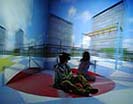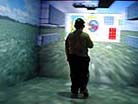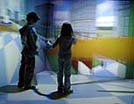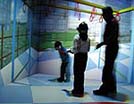Publications
- Roussou, M. (2006). Interactivity and Learning: Examining primary school childrens’ activity within virtual environments. PhD thesis, University College London, London, UK. [
 11Mb] 11Mb]
- Roussou, M. (2009). A VR Playground for Learning Abstract Mathematics Concepts. IEEE Computer Graphics and Applications, 29(1), 82–85. doi:http://doi.ieeecomputersociety.org/10.1109/MCG.2009.1
- Roussou, M., Oliver, M., & Slater, M. (2008). Exploring Activity Theory as a Tool for Evaluating Interactivity and Learning in Virtual Environments for Children. Cognition, Technology & Work, 10(2), 141–153. doi:1007/s10055-006-0035-5
- Roussou, M., Oliver, M., & Slater, M. (2006). The Virtual Playground: an Educational Virtual Reality Environment for Evaluating Interactivity and Conceptual Learning. Virtual Reality, 10(3-4), 227–240. doi:10.1007/s10055-006-0035-5
- Roussou, M., & Slater, M. (2005, September 21-23). A Virtual Playground for the Study of the Role of Interactivity in Virtual Learning Environments. In Proc. of PRESENCE 2005: The 8th Annual International Workshop on Presence, London, UK, International Society for Presence Research, pp. 245-253.

- Roussou, M. (2005). Can Interactivity in Virtual Environments Enable Conceptual Learning? In Proc. 7th Virtual Reality International Conference (VRIC), First International VR-Learning Seminar, Laval, France, pp. 57-64.
- Roussou, M. (2004). Examining Young Learners’ Activity Within Interactive Virtual Environments. In Proc. 3rd International Conference for Interaction Design & Children, June 1-3, 2004. pp. 167-168.

- Roussou, M. (2004). Interactivity and Conceptual Learning in Virtual Environments for Children. In ACM SIGCHI 2004 (CHI '04: Human Factors in Computing Systems) Extended Abstracts, April 24-29, 2004. pp. 1049-1050.
- Roussou, M. (2004). The Role of Interactivity in the Formation of Informal Educational Experiences. In Proc. 2nd International Museology Conference, 28 June - 2 July, Mytilene, Greece. [in Greek].

- Roussou, M. (2004). Learning by Doing and Learning through Play: An Exploration of Interactivity in Virtual Environments for Children. In ACM Journal of Computers in Entertainment, Volume 1, Issue 2: Educating Children Through Entertainment, ACM Press, New York, NY, USA.
Roussou, M. (2004). Examining Young Learners' Activity Within Interactive Virtual Environments: Exploratory Studies. Technical Report No. RN/04/08. London, UK: University College London, Department of Computer Science.
|
| |
Press
- This website won the Best Website award in the 2005 UCL Computer Science departmental research web pages competition, sponsored by searchspace®.
- October 7, 2005: Planet Science Newsletter, Issue 153, "Virtual Reality – Really!"

- See video excerpt:
|
| |
References
- Barab , S.A. Hay, K.E., and Barnett, M.G. Virtual solar system project: Building understanding through model building. Annual Meeting of the American Educational Research Association, Montreal , Canada , AERA 1999.
- Nardi, B. A Context and Consciousness: Activity Theory and Human-Computer Interaction. MIT Press, Cambridge , Massachusetts, 1996.
|
| |
About the Virtual Reality technology used in this research
The virtual reality technology used for this research is the ReaCTor™, which is a CAVE-like VR display. The CAVE®  (CAVE Automatic Virtual Environment) is a room-sized virtual reality system constructed (typically) of three translucent walls and a floor, onto which high-resolution computer-generated stereoscopic images are projected. The user views the projected stereoscopic images by wearing a pair of light-weight active shutter glasses, while her head and hand position and orientation is tracked through an Intersense IS900 tracking system. The user can physically move around the 3m cubic space as well as navigate around the virtual world by using a simple interaction device, similar to a mouse, which contains a joystick and buttons. This is also used to select and manipulate virtual objects. (CAVE Automatic Virtual Environment) is a room-sized virtual reality system constructed (typically) of three translucent walls and a floor, onto which high-resolution computer-generated stereoscopic images are projected. The user views the projected stereoscopic images by wearing a pair of light-weight active shutter glasses, while her head and hand position and orientation is tracked through an Intersense IS900 tracking system. The user can physically move around the 3m cubic space as well as navigate around the virtual world by using a simple interaction device, similar to a mouse, which contains a joystick and buttons. This is also used to select and manipulate virtual objects.
|
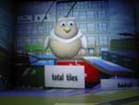 
Scenes from the Virtual Playground environment in a CAVE-like system and in a Reality Center. |
|

